

Viking Era, (800-1050) Padlock. How to make a crochet hook. Construction of Two Portuguese Style Dinghies (Small Boats) This project covers the construction of two rowboats that are primarily constructed with three sheets of plywood.
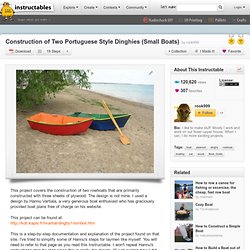
The design is not mine. I used a design by Hannu Vartiala, a very generous boat enthusiast who has graciously provided boat plans free of charge on his website. This project can be found at: This is a step-by-step documentation and explanation of the project found on that site. I've tried to simplify some of Hannu's steps for laymen like myself. If the link to Hannu's website ever changes (I discovered that it had) please Google Hannu Vartiala and his new website should come up.
This project tool me about 3 days for the first boat and 2 days for the second. I will also include tips for oar construction, which Hannu did not cover in his project. ACER - Associacao Cultural e de Estudos Regionais - A Batela do Rio Minho. A ‘batela’ começa pelo ‘fundo’: três pranchas de pinho reforçadas por cinco travessas que rematam em bico na proa e ficam cortadas transversalmente na popa (Fig. 2).
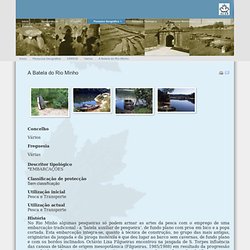
Utiliza-se o serrote para recortar a madeira e a machada para desbastar, operação que exige muita destreza e perícia. O corte em bico acompanha a ‘ponteira’, peça em pinho, de formato triangular e composta por duas metades: a superior e a inferior, unidas de modo a reforçar o ‘bico da proa’, zona onde ‘a batela leva muita pancada’ no dizer do Sr. Certal. Em seguida fixam-se com prego de forro as tábuas dos bordos acompanhando o perfil do fundo (Fig. 3). Para facilitar o trabalho usa-se um ‘serra-juntas’. Na serra eléctrica cortam-se uns sarrafos - as ‘escoras’- para servirem de reforço, pelo lado de dentro, dos bordos da batela (Fig. 4). Tablet Weaving: Graphing and Weaving Letters. Pin by Daniel Granath on Tablet weaving. Elenor's Stuff and Nonesense. The Ancient Craft of Tablet Weaving: Getting Started. This document is provided as is without any express or implied warranties.
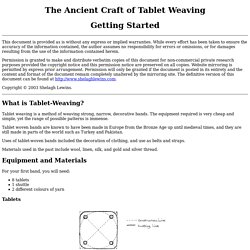
While every effort has been taken to ensure the accuracy of the information contained, the author assumes no responsibility for errors or omissions, or for damages resulting from the use of the information contained herein. Permission is granted to make and distribute verbatim copies of this document for non-commercial private research purposes provided the copyright notice and this permission notice are preserved on all copies. Website mirroring is permitted by express prior arrangement. Permission will only be granted if the document is posted in its entirety and the content and format of the document remain completely unaltered by the mirroring site.
The definitive version of this document can be found at Copyright © 2003 Shelagh Lewins. What is Tablet-Weaving? Tablet weaving is a method of weaving strong, narrow, decorative bands. Materials used in the past include wool, linen, silk, and gold and silver thread. Anglo-Saxon and Viking Crafts - Woodworking. Timber was the most important resource for the Anglo-Saxons and Vikings.
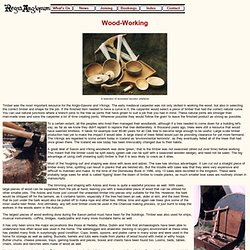
The early medieval carpenter was not only skilled in working the wood, but also in selecting the correct timber and shape for the job. If the finished item needed to have a curve in it, the carpenter would select a piece of timber that had the correct natural curve. You can use natural junctions where a branch joins to the tree as joints that have grown to suit a job that you had in mind. These natural joints are stronger than man-made ones and save the carpenter a lot of time creating joints. Wherever possible they would 'follow the grain' to leave the finished product as strong as possible.
Answer to Puzzle #41: rope around the earth, add 3 feet. 41.
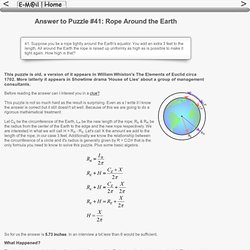
Suppose you tie a rope tightly around the Earth's equator. You add an extra 3 feet to the length. All around the Earth the rope is raised up uniformly as high as is possible to make it tight again. How high is that? What the heck is a chain? He "chain" is a unit of measurement that was invented in the early 1600's by an English mathematician named Edmund Gunter.

One chain equals 66 feet. This number may seem odd, but Gunter chose it because it was equal to one-tenth of a furlong, which was a common measurement used by English farmers and landowners. The furlong (220 yards or 660 feet) was the standard length of a furrow in a ploughed field ("furrow long" = furlong). It was supposedly the distance that a horse could pull a plough before needing to rest. An acre is one square furlong. If you look at old measuring systems, they are usually based on units of 2 or 3, or multiples of 2 or 3, like 4, 8, and 12. Decimals, however, are clearly superior for mathematical calculations. Although Gunter's chain has gone the way of the horse-drawn plough, we Americans have obstinantly stuck to our oddball acres and miles, thumbing our noses at the entire metric world.
To convert measurements of all sorts, visit Online Conversion.com.